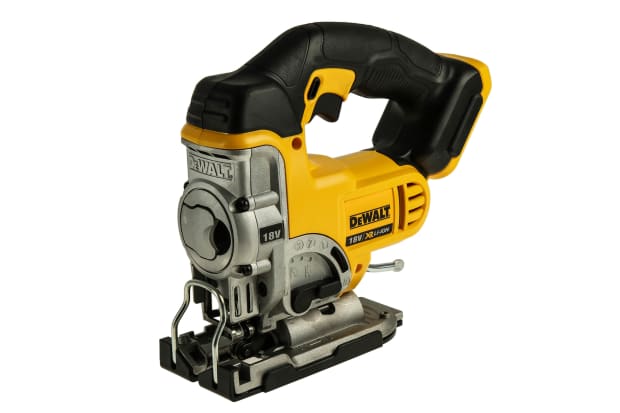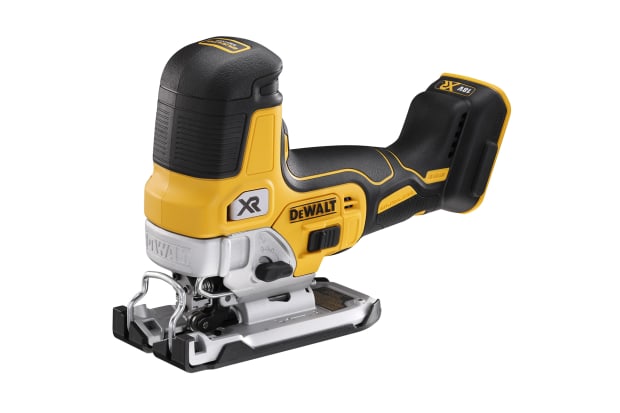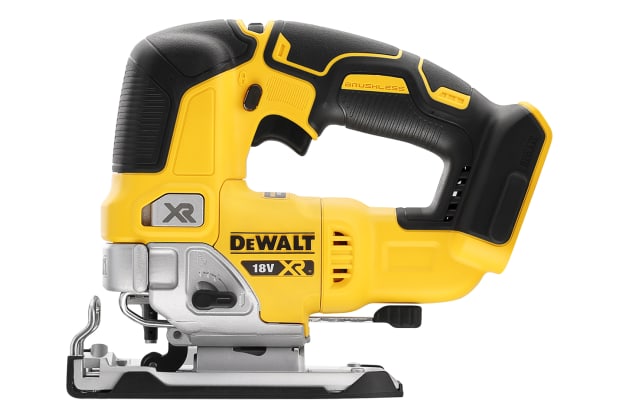- Published 8 Mar 2023
- Last Modified 29 Aug 2023
- 11 min
Jig Saws - A Complete Buying Guide
Explore the different types of jig saw, their uses, and how to use them safely in this complete jigsaws guide.

Reviewed by Luqman Said Abdullah, Technical Support Engineer (March 2021)
What is a Jigsaw Tool?
A jig saw is a power tool featuring a reciprocating blade used to cut differently shaped curves, including stencilled designs. They are used for a diverse range of purposes varying from cutting metal pipes to masonry materials.
The following factors should have a bearing on your choice of jig saw:
- Preferred method of holding the saw
- The range of jigsaw settings for cutting applications
- The type and compatibility of the cutting blade
What is a Jigsaw Used for?
The jigsaw is sometimes preferred to the circular saw for safety reasons. Additionally, jigsaws are better suited to precise applications, typically being used for cutting away wooden sections, repurposing, and upcycling. Adjustments can be made for cutting at different angles.
The types of materials that can be cut with a jigsaw include:
- Wood
- Plastic
- Metal
- Ceramic
Can You Use a Jigsaw to Cut Wood?
Wood cutting jigsaws are commonplace as this is one of the standard tasks where they are used. Therefore, cutting wood with a jigsaw is typically a simple task. However, there is some variation in the material thicknesses that jigsaws can cut safely and efficiently. The length of the blade, the saw base, the number of teeth and the tooth pitch, the softness of the wood, and the power of the jigsaw motor will all have a bearing on the suitability of the wood jigsaw.
Will a Jigsaw Cut Tiles?
Cutting tile with jigsaws is possible, if you have the right blade. A jigsaw blade for cutting ceramic tiles safely and efficiently will feature an abrasive diamond or carbide-grit edge. They can also be used for the precise insertion of notches, cuts, and openings.
Can a Jigsaw Cut PVC Pipe?
A high-powered jigsaw will be suitable for cutting tough and durable PVC piping. However, you should ensure that the piping is firmly secured on a worktop or other stable surface before undergoing the cutting process. There should also be minimal vibration to help prevent chipping.
Popular Brands
Bosch, DeWALT, and Makita jigsaws are among the most popular brands. Bosch jig saws are used across Europe and have a great reputation for reliability. DeWALT jigsaws are also of good quality and suitable for a range of tasks. Makita jig saw blades and tools are popular among professionals, with many models offering advanced functionality.
Some of the key benefits and applications for each brand's tools are listed in the content below:

Bosch Jigsaws
Benefits :
- Fast blade changes
- Speed control options on many models
Application :
- Bosch professional jigsaws can be used across a wide range of tasks
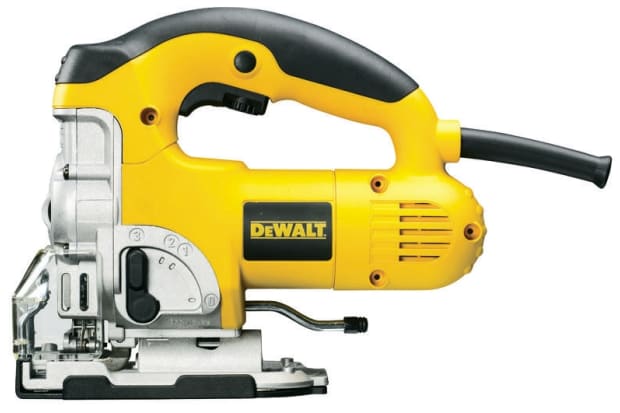
DeWALT Jigsaws
Benefits :
- Easy to use
- Many models feature keyless shoe bevels
Application :
- DeWALT jigsaws are ideal for professional applications. Some models can also be used to cut ceramics
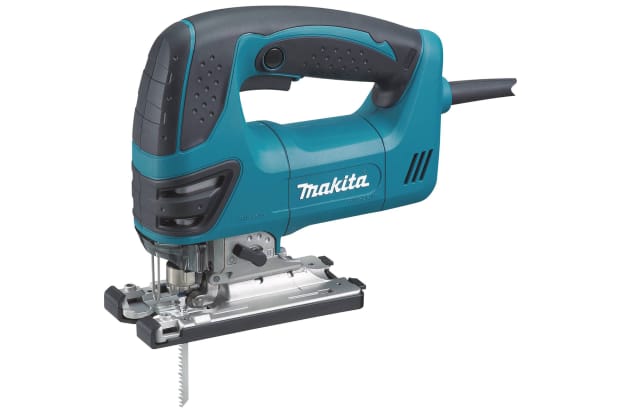
Makita Jigsaws
Benefits :
- High precision
- Strong and sturdy
Application :
- Makita jigsaws are great for a variety of tasks. They make a good, solid choice for many applications
Jigsaw Spotlight
This video highlights some of the core features and various applications of the 240V Bosch PST Universal+ Corded Jigsaw.
Watch the video to find out the various features of this jigsaw and how it could help complete your cutting tasks.
Corded vs Cordless Jigsaws
There are two principal ways to power jigsaws. Corded and cordless jig saws each have their own benefits and ideal uses, as explained below:
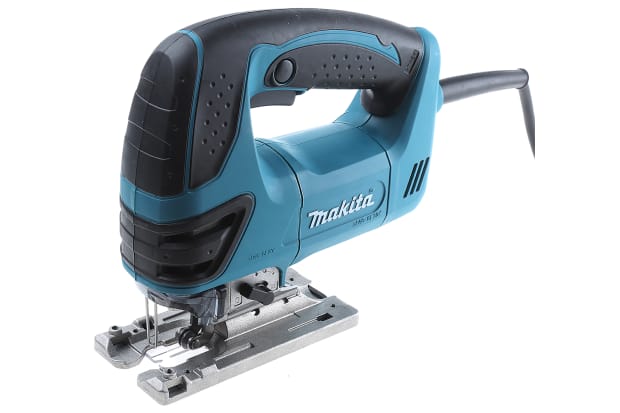
Corded Jigsaws
Corded jigsaws are ideal for cutting hard materials due to the continuous supply of power required for operation. These jigsaw hand tools can be connected to a standard wall outlet or power generator supplying 120 AC.
Robust and reliable, these tools are designed with an electric motor and a reciprocating saw blade.
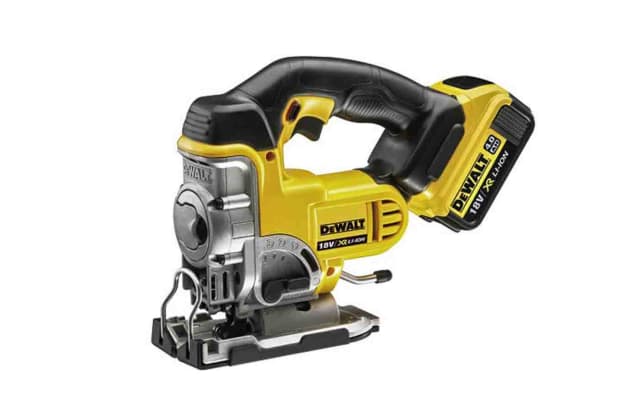
Cordless Jigsaws
Cordless jigsaws offer the ideal combination of convenience and versatility. There is no need to connect power leads, so the risk of trips and falls is effectively prevented. The jigsaw power is typically generated via an interchangeable lithium-ion battery; the battery voltage will have a direct bearing on the power of the jigsaw.
These battery-powered handheld jigsaws are especially well suited to cutting wood in hard-to-reach areas. Cordless jigsaws also offer the capability to precisely cut curves and holes.
How to Use a Jigsaw
Safety is key when learning how to use a jigsaw tool. You must ensure that you are wearing appropriate PPE and safety equipment including a face mask and goggles. You must also make sure that you have the correct blade fitted for the cutting application - the suitability of the blade may be specified on the packaging or label. The material that you are preparing to cut should be securely clamped to the work surface and you should also ensure that the cutting area does not extend beyond the edges of the work surface.
Whether you will be cutting straight with a jigsaw or you need curved cuts, it is important to take additional care over the pencilled drawing of the cutting line. This line will provide guidance, ensuring that you do not overcut the material. The greater the level of accuracy, the greater the chance of cutting precision. You should also ensure that the jigsaw settings are adjusted per the nature of the cutting application. This might involve making orbital and speed setting adjustments suited to the material. It should be possible to adjust the speed, depending on the type of cut that you are making. A slow speed will be suitable for highly accurate cuts, while a high speed will allow for low-vibration cutting of wood or laminate.
You should firmly grip the handle when preparing to cut and the base of the jigsaw should remain flat against the workpiece for the entirety of the cutting process. It might be necessary to adjust the setting depending on the level of resistance encountered. Once the necessary safety precautions are in place and you are confident to proceed, you simply have to squeeze the jigsaw trigger to set the blade into action. You might have to wait for a moment for the blade to start working at full speed.
Once the jigsaw is fully operational, you should position the base plate firmly and securely against the material. You may then guide the jigsaw along the cut line. If you feel a kickback or straining sensation, then you should reduce the cutting speed. The cut should continue until the end of the drawn line. Excess material should drop away freely, without any damage to you or contact with the power cord. Sandpaper may be used to smooth any rough edges after using the jigsaw.
Jigsaw Blades
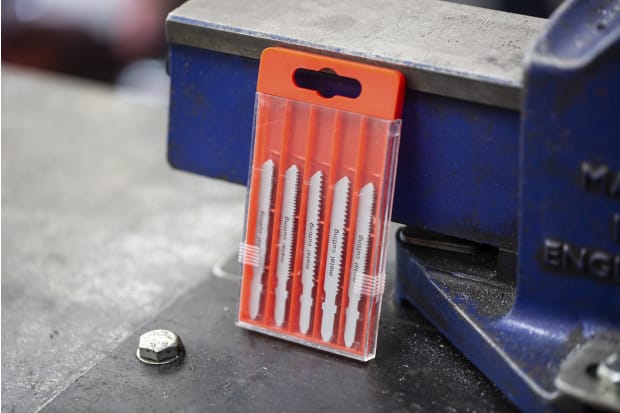
The jig itself is just one part of the tool – it is also important to choose high-quality jig saw blades that are ideally suited to your purposes. However, you may have some difficulty making this choice due to the wide variety of blades for jigsaws available from the leading manufacturers. The nature of the material and the type of cutting should be considered in your choice of which jigsaw blade to use.
Types of Jigsaw Blades
There is a wide range of jigsaw cutting blades suitable for different applications. The type of blade will also have a bearing on the speed of the machine and material finishing. Jigsaw blades may be categorised by the type of shank, the number of teeth, material composition, or suitability for the cutting of specific materials. You might select multi-purpose blades for affordability and convenience, but some blades are ideally suited to the cutting of specific materials.
Common jigsaw blade varieties include:
- T-shank jigsaw blades are the most common variety and are compatible across various modern jigsaws. The ease of fitting and general use makes these blades a popular choice. They feature a tang at the top of the shank, which is compatible with the jigsaw blade clamp
- Universal jigsaw blades – also known as U-shank jigsaw blades, they feature a distinctive U-shaped cut at the head of the shank. Today, they are less popular because many modern jigsaws feature a tool-less blade changing system for T-shank blades
Blade Material Types
The blade's material will have a direct bearing on its durability and suitability for different applications. You need to choose the most suitable material to ensure you are using the best jigsaw blades for your application.
The most common material types include:
- High carbon steel jigsaw blades – these blades are the most affordable and flexible. They are used for a variety of wood cutting purposes
- High-speed steel jigsaw blades – these blades offer relatively high levels of durability and heat resistance. They can be used for various applications including cutting metal, plastic, and wood
- Bimetal jigsaw blades – these bi-metal blades are made from a combination of steel and offer high levels of durability. They can be used with wood but are primarily heavy-duty metal cutting jigsaw blades
- Tungsten carbide jigsaw blades – these blades set the standard when it comes to heat resistance and durability. These jigsaw tile cutting blades can also be used for cutting solid materials including ceramics and stainless steel

How Long Do Jigsaw Blades Last?
The expected lifespan of a jigsaw blade will depend on the application of power settings and use for different cutting purposes. All jigsaw blades will wear down and lose their cutting ability when used repeatedly. However, you should sharpen any blades before fitting and avoid attempting to force the jig if there is noticeable cutting resistance. There will be an obvious difference in the sharpness of new and worn blades.
How to Change a Jigsaw Blade
You will find a spring-loaded lock at the top of the jigsaw. The purpose of this lock is to keep the jigsaw blade secure during the cutting process. The first step in the attachment of the blade will be to position the spring-loaded lock so that it is parallel with the blade guide. You should then proceed to carefully insert the blade and release the lock. You can test the security of the blade by giving it a gentle tug.
You should ensure that the jigsaw blade has cooled before removing it. It will also be important to remove the battery from the jigsaw. Only then should you push the spring-loaded lock up to release the blade.
Which Jigsaw Do I Need?
There are a variety of factors to consider when choosing a jigsaw. You should account for the expected regularity of use, the merits of corded vs cordless models, and the suitability of the blade. The best jigsaw for you will depend on factors such as the material that you are planning to cut and the features that you consider essential. Additionally, it might be the case that you prefer a certain brand, for example.
Regardless of whether you are looking for the best cordless jigsaw or the best jigsaw for cutting metal, other key considerations should include:
Jigsaw Stroke Length
The stroke length is specific to the amount of distance that the blade covers in a vertical direction during the cutting process. The higher the stroke length, the greater the cutting efficiency. Tools with the longest stroke lengths are also suitable for cutting a diverse range of materials.
Jigsaw Power
The required power will depend on the cutting purposes and expected regularity of use. A jigsaw with motor power over 500w will be sufficient for most cutting tasks. However, you should invest in a jigsaw with over 700w of power if you are going to be using it regularly to cut hard materials. It is also worth remembering that the power of a cordless jigsaw is represented in Volts.
Jigsaw Speed
The cutting speed will have a bearing on the materials that can be cut:
- Slow – jigsaws with a slow cutting speed of between 500 and 1,000 strokes per minute are suitable for cutting ceramics, wall tiles, and glass
- Medium – a mid-range cutting speed of 1,500 to 2,000 strokes per minute makes the jig suitable for cutting plastics and non-ferrous materials
- Fast – jigsaws with a fast cut speed setting of over 2,000 strokes per minute are exclusively suited to cutting wood
Check out our handy comparison of popular jigsaws to help you decide on the most suitable model for your requirements.
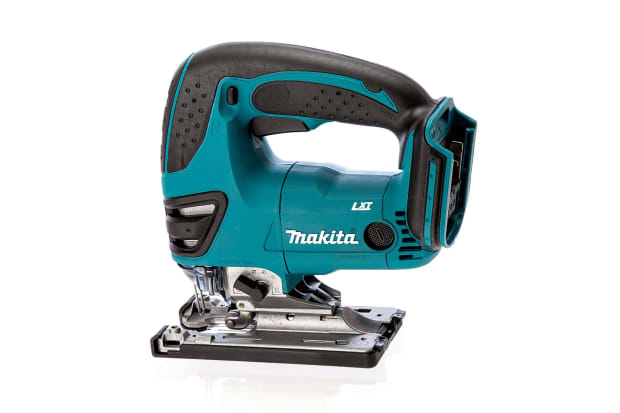
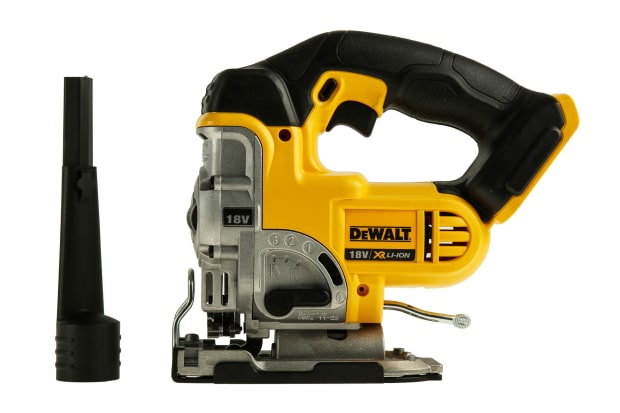
DeWALT DCS331N-XJ Cordless Jigsaw
Stroke Length :
- 26mm
Power :
- 18V Li-ion battery
Speed :
- 3000 SPM
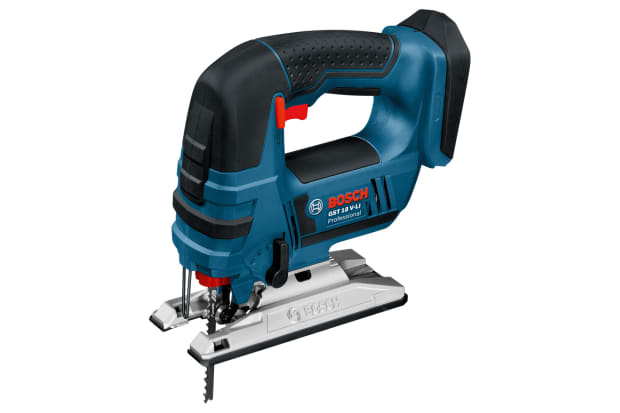
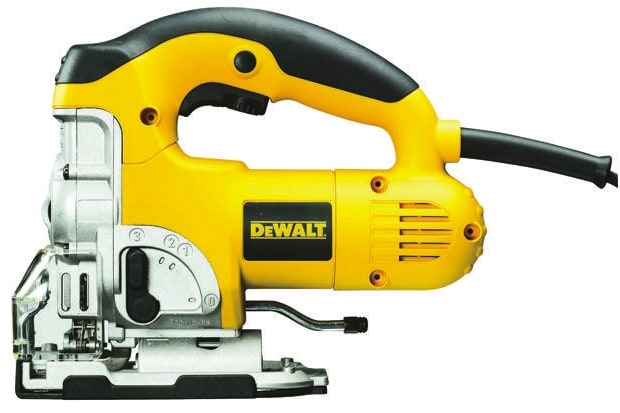

Power Jigsaws for Sale
RS Components has a wide selection of top-quality tools for you to choose from. Varying from basic, cheap electric jigsaws right through to the latest professional models, there are plenty of options to meet your needs. How much is a jigsaw? What brands and features are available? Some of our most popular tools are displayed below:
Products & Prices
FAQs
Can a Jigsaw Cut Metal?
It is important to choose a jigsaw with the appropriate type of blade and power for the safe, precise cutting of metal. A professional jigsaw with good specifications may reasonably be expected to cut through 10mm steel and non-ferrous metal with a thickness of up to 30mm.
How Long Do the Batteries Last on a Cordless Jigsaw?
The expected battery life of a cordless jigsaw will depend on the specific model and the different types of cutting tasks being carried out. It is always advisable to have a spare fully-charged battery and a mains connected battery charger within easy reach.
What Does Voltage Mean for a Cordless Jigsaw Tool?
Voltage is the main indicator of a cordless jigsaw’s power. The Voltage level will vary between models, but most cordless jigsaws feature 12 or 18-Volt batteries. The Voltage directly relates to the power of the motor and the overall efficiency of the tool.
What is Jigsaw Speed?
Jigsaw speed can be measured in terms of either rotations per minute (RPM) or strokes per minute (SPM). Jigsaws can also be categorised by fixed or variable speed. Fixed speed jigsaws should be fine for occasional use, but variable speed jigsaws should be selected if you are going to be regularly cutting materials with different levels of resistance. The ability to set a low speed will be particularly important if you are going to be scrolling as you cut. The maximum speed setting of a typical corded jigsaw ranges from 2800spm to 3100spm.
